The travel industry has reached its peak development over the last two decades, completely transforming the way we plan both long-distance and short getaways. We’ve moved from sharing contacts, making phone calls, and manually filling out spreadsheets to digital platforms, price alerts, and collaborative online trip planning. These days, it’s hard to imagine even a weekend trip without using at least a few apps.
And that’s exactly the point… what has become a necessity has also turned into the biggest pain point for travelers. The travel market is well aware of the app overload –this is evident in how market leaders are shifting their focus from narrow segments (like accommodation booking or price tracking) to offering all-in-one services. This is what today’s user is looking for – not more features, but more time (and space on their phone) to manage it all.
All-in-one travel apps – an answer to the shift in customer needs
All in one travel app capture this demand, offering an unmatched convenience. They save time, allow bundled service purchases at lower prices, and enable travelers to plan and execute their entire trip within a single tool.
Since all data remains in one app, providers gain much broader personalization capabilities and can fully leverage the potential of GenAI to generate tailored content and materials, as well as more accurately target value-added services. It’s a win-win – users get a smoother experience, and businesses get deeper engagement and better conversion.
Future-proof all-in-one travel app – which features should it have?
Not every app of this kind will succeed. In our article, we compare the key travel app features essential for success in 2025 – features no all-in-one travel app can afford to overlook today.
We analyze the most popular solutions on the market to showcase the availability of specific features, while also exposing untapped niches with strong potential. And finally – by stepping into the shoes of several key user profiles – we highlight a few travel features of the future that are likely to become increasingly sought after as trends evolve and the industry shifts direction.
Ready for the journey?
1. Booking accomodation
Accommodation booking is a fundamental feature available in virtually every popular travel app. The main difference lies in whether the platform acts as an aggregator or works directly with hotels and other lodging providers. This matters because it affects:
- the user experience (aggregators often offer broader selection and price comparison, but may have limited control over booking issues);
- the platform’s accountability (direct partnerships usually mean greater responsibility for service quality);
- how problems are resolved (aggregators might redirect users to third parties, whereas direct platforms are more likely to handle issues internally).
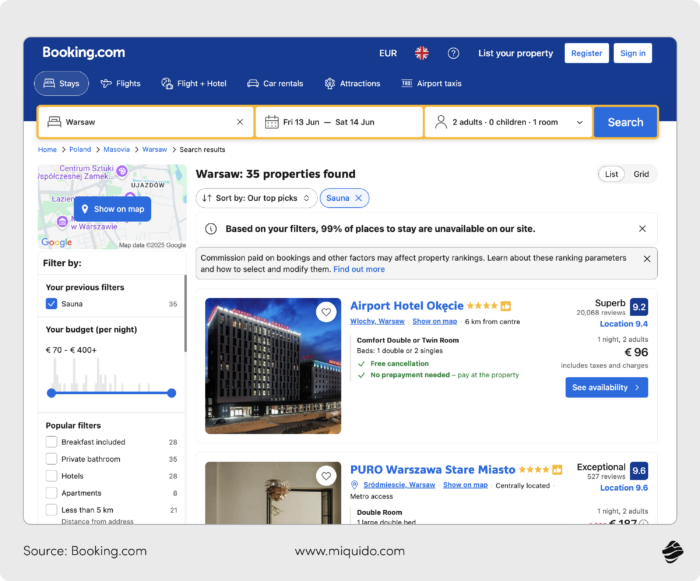
Since nearly every popular all-in-one travel app – from Booking.com to Kayak – offers this feature, how can it be used to build a competitive advantage? The keyword is filters. It’s not the quantity that matters most, but the quality. Filters should allow for highly precise narrowing of search results without overwhelming users with too many choices. On top of that, they must be intuitive for all users and easy to use on a mobile interface.
It’s also crucial to ensure inclusivity when it comes to search result views –such as list view, map view, and also calendar-based view for date-flexible users, and visual/image-based view for inspiration-driven travelers. Here, too, mobile optimization is key – especially for maps, which are often the Achilles’ heel of many travel apps.
As you can see, involving experienced UX writers and designers is essential – ideally ones with hands-on experience in building advanced map interfaces. Miquido has quite a bit of expertise in this area, having implemented such elements in projects like YouMap, Step, and TUI.
2. Flight booking
Flight booking is another feature that no modern all-in-one travel app can realistically go without. With the exception of Airbnb, all major platforms on the market offer it – including TripAdvisor and TUI, not to mention Skyscanner, where it remains a core feature.
Just like with accommodation booking, filters are what truly determine a competitive edge here. Including more advanced filters – such as flight details like aircraft type, carbon footprint, or in-flight services –can help secure a loyal user base. On Kayak, for instance, users can set preferences for layover duration or choose only flights with Wi-Fi access.
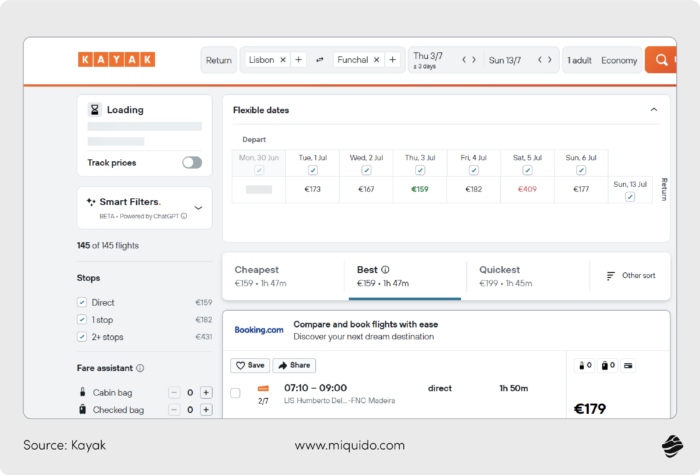
Smart filters powered by conversational search are quickly becoming standard – and it’s about time, considering how much LLM models have reshaped user habits and expectations. It’s also essential to tailor search options to the needs of different user groups – not just those with well-defined plans, but also flexible travelers who base their decisions on offers and price.
For apps to truly stand out, they must offer easy access to all the features that matter. Features like offline access to itineraries and flight details are critical for users on the go, especially when connectivity is limited.
3. Car rentals
Including car rentals among the available features is a logical step for any all-in-one travel app that already offers flight and accommodation booking. A large percentage of users want to drive off straight from the airport in their rental car, and with this feature available, they can do so seamlessly.
Here too, high-quality filters are a must. In the case of the Skyscanner app, developed by Miquido, users can, for example, filter rental cars based on fuel policy, mileage, provider rating, flexible booking, cleanliness, or customer service.
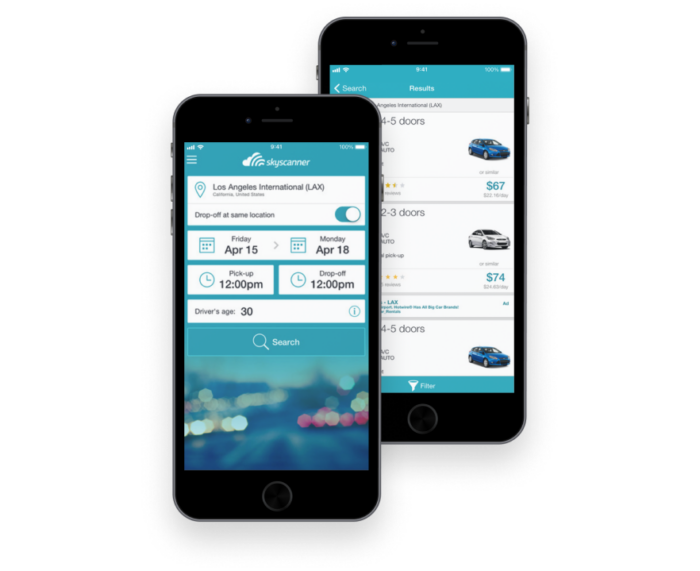
What else beyond filters? If the app has access to the user’s flight itinerary and accommodation booking details, its algorithms can suggest the most logistically and cost-effective option by matching the exact arrival point and accommodation location with the location of car rental offices. What’s more, if the user has planned their itinerary within the app, the system can also factor in weather conditions and terrain requirements, aggregating not just the best, but also the most suitable offers.
At the moment, very few algorithms in travel apps are personalized to this extent – but that could soon change, given the current level of competitiveness in the industry.
4. Bus & train booking
Unlike the previously mentioned features, bus and train booking is not a common component of all-in-one travel apps – though it really should be. The potential of this feature remains largely untapped by industry giants: it’s not offered by Booking.com, TripAdvisor, or Hopper, and even on Kayak it’s quite limited. This is likely due in large part to targeting – many users of these apps typically fly directly to and from their destinations.
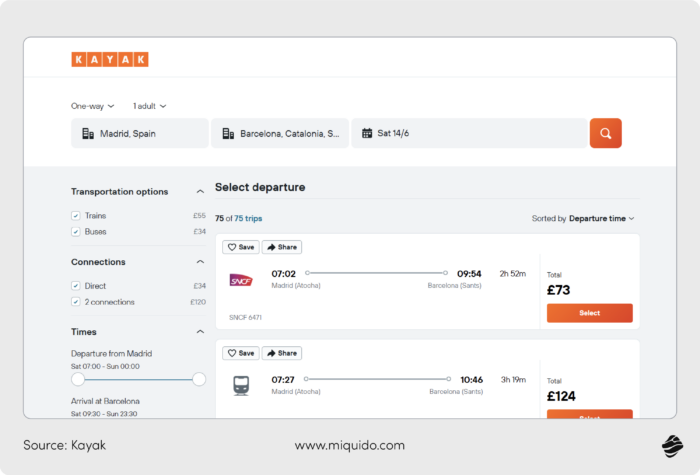
However, it would be a mistake to underestimate the potential of bus and train travel. As environmental awareness continues to rise, demand for these transport modes will only increase, especially in Europe or East and SE Asia. The network growth of high-speed train in the last twenty years has been astounding – global HS‑rail mileage surged from under 10,000 km in 2000 to nearly 60,000 km by 2021, largely driven by China’s expansion. In the EU, growth is also evident – Spain alone saw 32.4 million high-speed rail passengers in 2023 (+37% vs 2022).
Initiatives launched by certain EU countries – such as Germany and Portugal – are further fueling demand for train travel. Buses remain a strong alternative as well, with growth driven in part by international carriers known for regular promotions, like Flixbus. This segment appeals especially to budget-conscious travelers, digital nomads, and younger users seeking flexible, low-emission transport options.
Looking ahead, integrating bus and rail booking into all-in-one apps could fill a significant market gap while aligning with sustainability trends, government policy incentives, and evolving user preferences. Enabling multi-booking across international vendors, with filter options that facilitate access to special offers and bundles without requiring local language competencies, could be a market game-changer –earning you some staunch supporters! In the end, the ticket discovery and booking transparency problem is one of the most pressing issues in the bus and train travel niche.
5. Travel itinerary management
Itinerary management remains an underdeveloped feature in many travel apps – offered by TUI, Expedia, and Kayak, yes, but still missing from most all-in-one platforms. Yet it’s absolutely vital for an app aiming to stitch together a full journey and present the big picture, not just individual bookings.
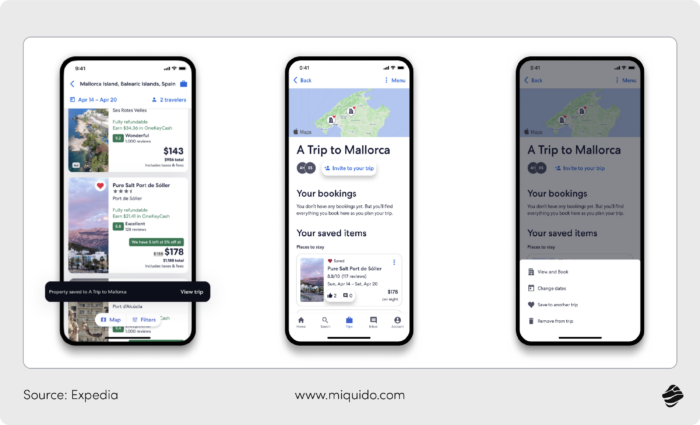
Today’s user wants everything at their fingertips –no hunting across apps for tickets, confirmations, and lists. A robust itinerary feature can deliver that. It’s crucial that it integrates with social media and allows collaborative planning, just like Expedia’s Trip Planner does. Its trip planner enables you to invite friends and family to create a group trip; once they accept via email, these fellow travelers can view the trip, save items, comment, like their favorite options, and help decide on what to book.
How to gain the hearts of younger demographics, which have entirely different approach to travelling? Research shows Gen Z travelers struggle without a centralized platform to plan and collaborate – nearly 88% follow travel influencers on TikTok, and 51% rely on itineraries generated by AI. They deeply dislike fragmented information and expect seamless mobile experiences.
To attract a steady flow of younger users, your itinerary tool should support real-time group editing, AI-generated smart suggestions, visual itinerary sharing (with the ability to add photos), packing list, and seamless in-app coordination among fellow travelers.
6. Things to do / Activities
The days of all-inclusive vacations are long gone – millennials have shifted toward experience-driven tourism, and Gen Z is proudly continuing that trend. Much of this change is fueled by social media, where everyone wants to stand out rather than repost identical photos from the same crowded landmarks. A cannoli-making workshop with a Sicilian family? A walk through Barcelona’s okupas? These unique moments are the real currency of modern travel, something the smartest travel app providers understand very well.
Some, like Airbnb, offer dedicated modules (e.g., Airbnb Experiences) that connect local guides with curious travelers. Others, like Booking.com, provide access to exclusive experiences through third-party integrations. The key to making this feature successful lies in well-tailored suggestions, which depend on robust user data retention and smart recommendation algorithms.
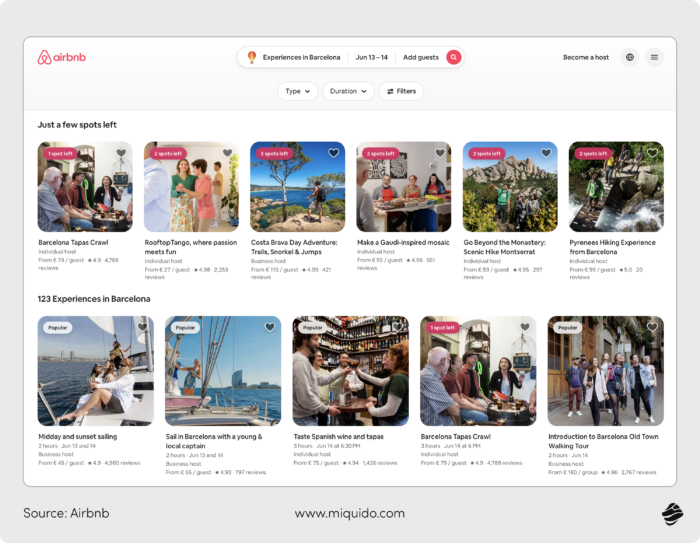
Advanced filtering is a must, allowing users to browse by location, duration, availability, or even opening hours. A transparent review and rating system is equally critical – users engaging with this feature will heavily rely on others’ feedback when booking local adventures.
This type of feature adds immense value to any great app by catering to users planning anything from spontaneous getaways to fully curated road trips. Apps that offer many features and throw in expert tips to help users select truly local, off-the-beaten-path experiences are more likely to stand out and retain their audience.
7. Trip inspiration & guides
With the overwhelming amount of content and recommendations flooding social media, travelers often feel lost. What should they see? Where should they go? What should they try? All-in-one travel apps have a unique opportunity to turn this chaos into an advantage – by becoming a trusted source of verified information and inspiration.
Instead of scrolling endlessly through influencer profiles, users can simply open a free app that provides curated guides and inspirational lists, and immediately book their trips, transport, and excursions, all in one place. Maximum convenience, time saved.
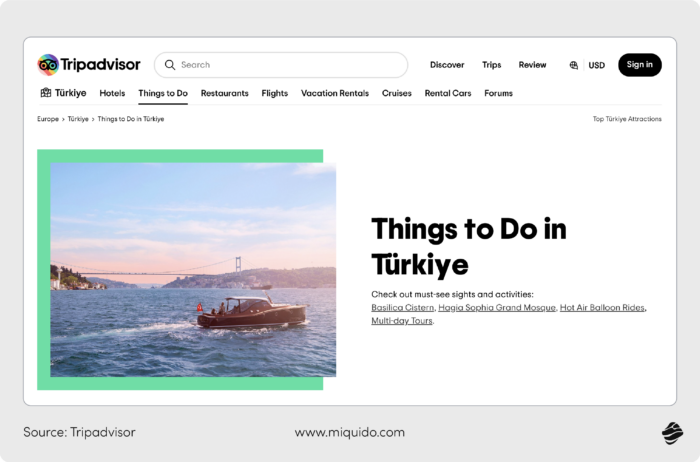
By stepping into the role of a travel curator, a booking and trip planning app can use available user data – such as upcoming travel plans, habits, favorite destinations, and interests –to generate tailored, inspiring content. That content can lead users directly into booking and checkout modules, taking advantage of the shopping momentum and significantly increasing conversion rates. Many users say they absolutely love this kind of seamless inspiration-to-booking flow.
Sound like a lot of work? Not anymore. Thanks to generative AI, this strategy is within reach without requiring massive resources. All you need is the right data mix and an integrated LLM module that can generate content aligned with your brand’s tone of voice, using high-quality sources and in-app offerings.
With our AI Kickstarter Framework, you can implement this innovation seamlessly – and 65% more cost-effectively than traditional development. This feature can also be positioned as part of a pro version or included in a monthly subscription plan for additional value.
Currently, most all-in-one travel apps do offer guides and inspirational content, but in a limited, non-personalized form. That leaves a big opportunity for differentiation. If you build it right, users will not only stay longer – they might even say they absolutely love your app. Plus, pairing this content with practical tools like confirmation emails syncing and post-booking checklists can round out the full experience.
8. Price alerts & predictions
The days when price played a secondary role in travel decisions are long gone. While tourism statistics have largely bounced back after the post-pandemic slump, the pricing landscape in travel services has shifted significantly, especially when it comes to airlines and bus transportation. Deep discounts have become rare, and accommodation prices have also climbed steadily.
This natural consequence of an economic downturn hasn’t dampened the enthusiasm for travel – instead, it has reshaped traveler habits. It has also brought price alerts and predictions into the spotlight. Today, such features are a standard offering found in most all-in-one travel apps on the market.
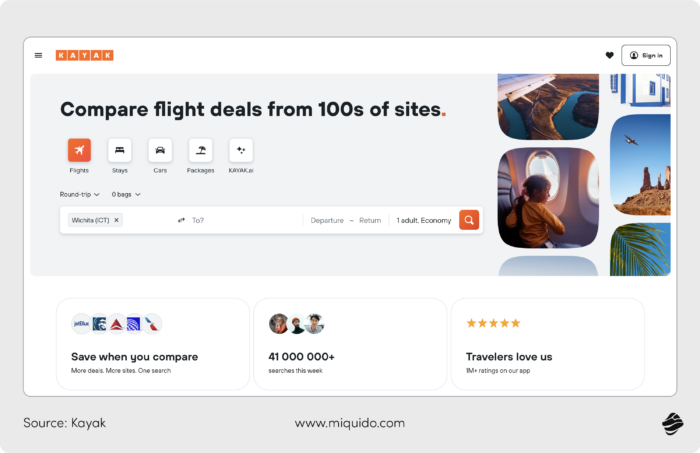
The question is no longer whether to implement price alert functionality, but rather how to turn it into a powerful tool for increasing engagement and raising cart value. In addition to a well-designed set of filters, the key lies in mastering the use of push and in-app notifications. They must strike a careful balance – not too frequent, not too sparse – and their tone and content should be both eye-catching and personalized.
Looking for inspiration? Duolingo, Spotify, and Swarm have all mastered the art of highly effective notification systems.
For your travel app, combining price prediction tools with timely updates and curated travel information, especially in a free version, can help boost retention while building user trust, an increasingly rare commodity in a cost-conscious market.
9. Loyalty & rewards programs
In light of the economic changes described above, another feature that offers real value to users is loyalty and rewards programs. When executed well, they become a powerful tool for travel app providers – boosting conversion and retention by incentivizing loyalty to a single platform.
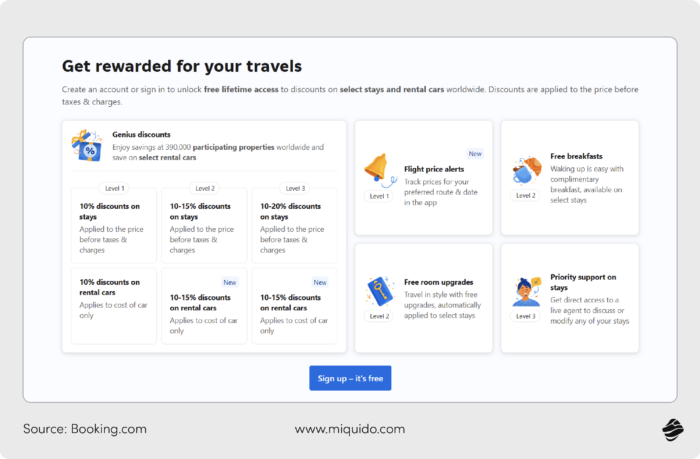
It’s no surprise that many apps have launched such programs – Booking.com’s Genius, Expedia’s One Key, and Hopper’s Carrot Cash are prime examples. What matters most in these programs? First and foremost: transparent point-earning rules, a bug-free automated system, and client-side access to progress tracking.
With these components in place, users feel in control of their progress and motivated to participate. An added engagement booster can be gamification elements like tiered rewards, badges, progress bars, challenges, and leaderboards, which drive ongoing interaction and encourage users to strive for the next level.
10. Multi-service package booking
Package deals are another essential feature for all‑in‑one travel apps. Offering access to various travel services makes it a natural, proven way to drive sales. For target groups that value peace of mind –especially Gen X – it’s industry low-hanging fruit. The package-deal feature combines the autonomy of self-planned travel with the familiarity of traditional travel agency experiences.
Although package deals are often associated with older travelers, statistics show growing interest among younger users as well. According to Reuters data from 2024, 56% of 25–34‑year‑olds choose “shopping‑basket” style packages (flights + lodging).
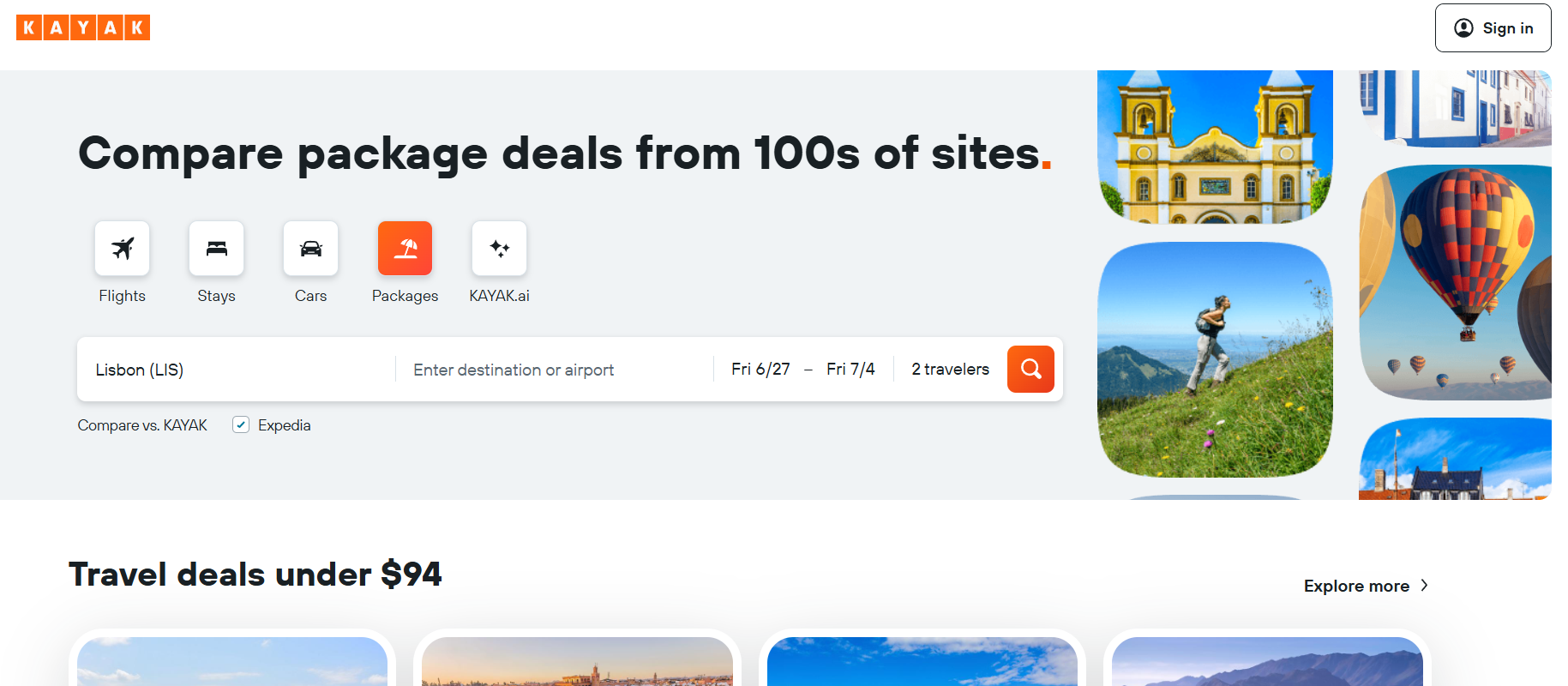
Flexibility is key – and that’s precisely what providers like TUI emphasize. Users aren’t tied to rigid bundles; instead, they can customize packages to fit their preferred travel timeframes and airline choices.
Comparing the most popular all-in-one travel solutions: Understand the competition
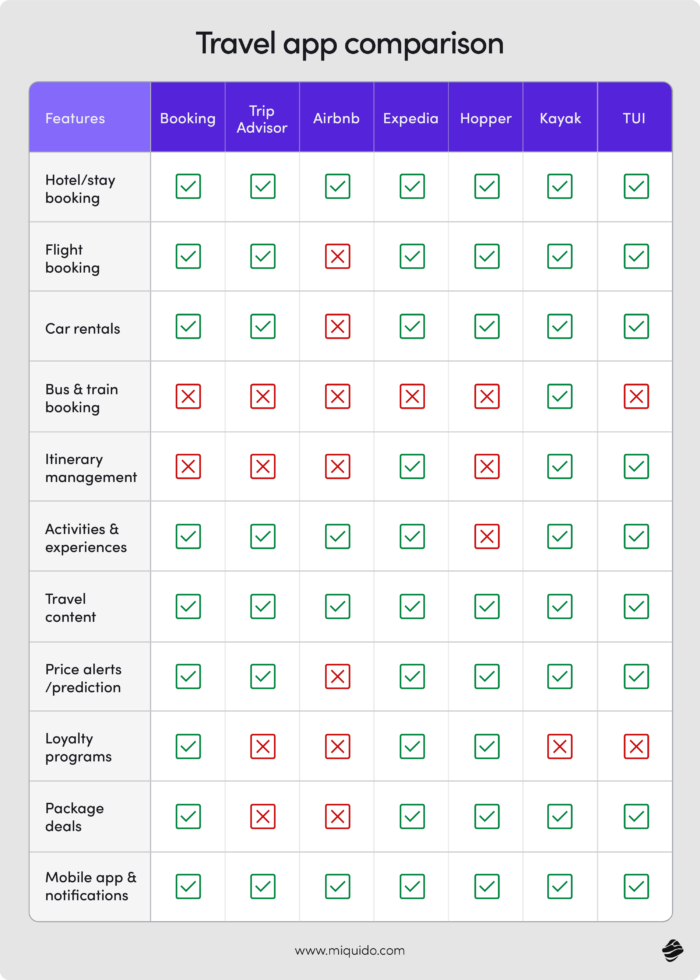
All in one travel app features of the future: Fill the market gaps with innovative functionalities
The changing geopolitical and economic landscape is closely tied to the directions in which the tourism market will evolve. Let’s dive into the potential for innovative features that these changes unlock.
Currency converter
Often seen as a simple utility, the currency converter is stepping into the spotlight. As exchange rates shift and travelers become more mindful of spending, real-time currency insights are turning into a valuable feature for everyone—not just deal seekers. It’s a small tool with big potential to enhance planning, confidence, and overall user experience.
What this means for travel apps
To meet these needs, the feature must go beyond static rates. A modern converter should include historical trends, bank fee estimators, and offline access, ideally integrated into budgeting tools that reflect actual spending categories like food, lodging, or transport.
To turn this into a true competitive advantage, focus on usability and context. Tie the converter to live trip data, display currency impacts during booking flows, and offer subtle alerts when local prices change significantly. Multilingual support, intuitive design, and personalization (e.g., learning user habits) can make your app feel smarter and indispensable.
Visa assistance
Geopolitical changes across many parts of the world are making travel increasingly complicated. It’s clear that Europe is moving toward a more restrictive visa policy. In 2025, the UK launched its Electronic Travel Authorization (ETA) – initially for non-EU nationals in January, extending to EU citizens by April. Applicants must pay £10 for a multi-entry permit valid for up to two years. The EU is also preparing to roll out a similar system.
We can also expect tighter restrictions in the U.S., where travel visa strategy has fluctuated significantly over the last 25 years. During Donald Trump’s first presidency, new travel bans were introduced, which the Biden administration later replaced with visa policy modernizations. Given Trump’s return to office and his recent actions, another wave of restrictions on travel visa policy is highly likely.
What this means for travel apps
Most likely, a growing demand for visa assistance and visa-related information. At the moment, none of the popular apps offer such features.
A well-designed visa assistant should combine real-time country-specific requirements with an interactive Q&A experience tailored to the user’s passport and destination. To keep it inclusive and useful, the assistant should support multiple languages and explain complex policies in plain terms, also offering visual guides and links to official application portals.
Responsible tourism
Travel has become an integral part of the lifestyle for many social groups, but attitudes toward the tourism industry in some of the most popular destinations have noticeably cooled. In Spanish cities –especially Barcelona –protests against mass tourism are now commonplace, and in recent times, other European cities have joined the movement.
Tourism brings significant revenue to municipal budgets, but it also negatively impacts prices, the local housing market, the environment, and residents’ access to public spaces and services. Some digital platforms – initially created to support small local businesses – have become tools for speculation, exacerbating difficult housing situations.
What this means for travel apps
In this context, a new type of traveler is emerging – more conscious and seeking ways to travel that minimize their negative impact on the local landscape. Features that allow users to verify travel-service providers for ethical, sustainable, and locally responsible practices, as well as to plan trips with the exclusion of overtourism hotspots and mass-touristic activities, will likely see growing demand in the years ahead.
Travel app features with potential and no market coverage: Get inspired!
What else may the users be currently searching that the all-in-one travel applications fail to provide? We picked three personas that are gaining significance in the current travel landscape but their needs seem to be overlooked by the market. Who knows – maybe you will be the first one to cater them?
1. Anna – the travel influencer
- Profile: 31 y/o, digital nomad, constantly traveling, monetizes her trips via content and brand deals.
New feature ideas:
- Collab-ready properties & workspaces
A filter or marketplace for hotels, Airbnbs, or co-living spaces that:- Support content creators (photo-worthy spots, lighting details, tripod space)
- Offer influencer packages (early check-ins, free stays for promo, affiliate links)
- Brand partnership matchmaking tool
A section where brands (hotels, tour operators, cafes) list opportunities for sponsored stays, collabs, or product features in return for promotion – like a travel-freelancer board.
2. Teresa – the retired passionate traveler
- Profile: 68 y/o, widowed, financially comfortable, loves discovering new places but lacks companions.
New feature ideas:
- Trusted solo-travel companion matching
A vetted, optional social feature to find travel buddies (same age group or preferences) for group tours, cruises, or even dinner. Emphasizes safety, interests, and verified identities. - Care-assist travel mode
A toggle that enables:- More accessible routes
- Accommodation suggestions with medical services nearby
- Alerts for check-ins to emergency contacts
- Step-by-step walking guides (with breaks & safety info)
3. Karol – the budget-savvy Erasmus student
- Profile: 22 y/o, lives in a shared flat in Madrid, loves cheap travel, spontaneous plans, and cultural immersion.
New feature ideas:
- Backpacker sync + shared cost planner
An opt-in hub to:- Find other travelers to share rides, Airbnbs, or group discounts
- Track per-person split costs (flights, food, stays)
- Use a simple group chat & calendar sync
- Last-minute student deals engine
A curated daily feed of:- Ultra-cheap last-minute options (flights under €30, stays under €15/night)
- Student-only promo codes
- Cultural free-entry days (museums, landmarks)
4. Joe – the architect & single dad
- Profile: 43 y/o, frequent traveler with his two daughters (ages 7 and 10), focused on quality, safety, and meaningful bonding experiences.
New feature ideas:
- Kid-first trip designer
A trip planner that:- Filters only kid-friendly activities, stays, and restaurants
- Offers sample day plans (mix of fun + rest)
- Provides safety ratings and “kid boredom index” per city
- Solo parent travel assist
Features include:- Tag-teaming services (childcare at hotels, parent-daughter events)
- Packing checklist for single parents
- “Emergency Local Help” button (connects with embassy, hospitals, child help lines)
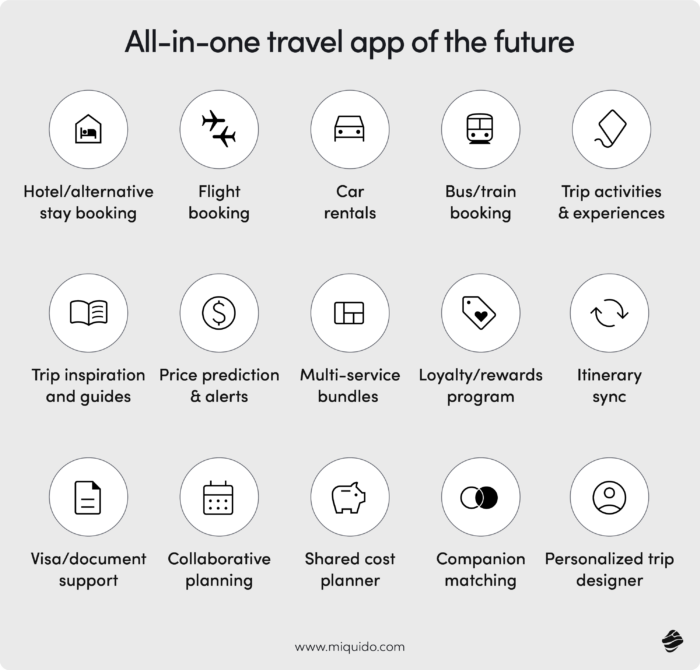
As travel becomes more dynamic – and often more complex – users increasingly expect more from all-in-one travel apps. From price prediction tools, loyalty programs, and multi-service booking options to personalized push notifications and ethical travel filters, expectations are rising.
Going forward, the most successful apps will be those that deliver not just bookings, but real-time updates, gate change alerts, and a seamless ecosystem of services – from a currency converter to localized visa information. In an era of shifting global politics and user behaviors, convenience, flexibility, and transparency are the real premium.

![[header] all in one travel apps top features 2025](https://www.miquido.com/wp-content/uploads/2025/06/header-all-in-one-travel-apps_-top-features.jpg)
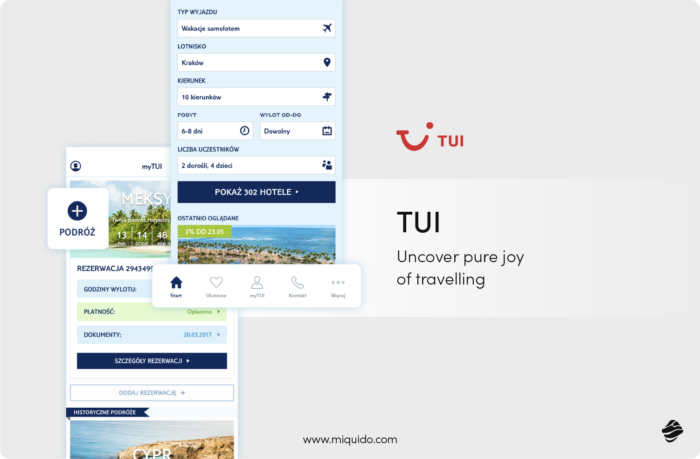



![[header] all in one travel apps top features 2025](https://www.miquido.com/wp-content/uploads/2025/06/header-all-in-one-travel-apps_-top-features-432x288.jpg)
![[header] case study ux optimization and functionality analysis in the expansion of a booking platform into asian markets](https://www.miquido.com/wp-content/uploads/2025/04/header-case-study_-ux-optimization-and-functionality-analysis-in-the-expansion-of-a-booking-platform-into-asian-markets-432x288.jpg)

![[header] top 15 travel app features](https://www.miquido.com/wp-content/uploads/2017/09/header-top-15-travel-app-features-432x288.jpg)